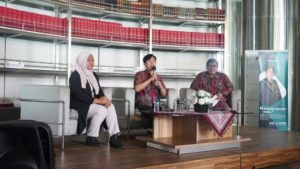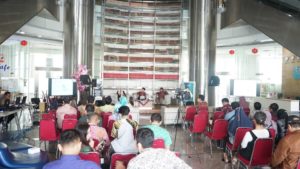Mapping Collection of Southeast Asian Maritime World at National Library of Indonesia
05 June 2023

Discussion of Southeast Asian maritime world at National Library of Indonesia (Photographed by Elvandio Ramadhan, National Library of Indonesia)In 1940, a legendary Indonesian songwriter, Ibu Sud, created a song entitled “Our Ancestor” (Nenek Moyangku). The lyrics of the song go: “Our ancestor is a sailor. They love to cross wide ocean. Conquering wave fearless. Going through storm regularly.” This song reflects the love for the sea. Ibu Sud wants to remind Indonesians that their ancestor was a seaman and that the sea is not a “strange” environment for Indonesians. In the past, the sea is not viewed as a barrier, but it connected Indonesia with “other worlds”. Merchants, princes, ulama, soldiers, travellers, monks, sailors, diplomats from foreign countries visited Indonesia through seas and oceans, enriching its cultural life and created a multicultural society not only in Indonesia, but also in the Archipelago of Southeast Asia.
Maritime activities of Southeast Asians in the past can be traced by exploring the collections in libraries and archives in several places. Sejarah Melayu (Malay Annals), for example, is an old Southeast Asian manuscript which tells us about maritime activites in the Malay World. Collections of rare books, rare periodicals, maps, and photographs are primary sources of Southeast Asian maritime history. News in rare newspapers and magazines, for example, contain much information regarding pirates’ attack, smuggling and slavery conducted on sea.
The National Library of Indonesia (NLI) is a suitable place for those who want to research Southeast Asian maritime history. The library has an extraordinary collection regarding Southeast Asia. The Division of Rare Monograph and Periodical (Klasika) houses several rare collections which can be useful for people and researchers who are researching about Southeast Asian maritime history. Therefore, the library often promotes its collection in order to create awareness in people in Indonesia and other Southeast Asian countries.
On 9 March 2023, the NLI conducted a special discussion (Jasmerah Discussion) regarding the Southeast Asian maritime world. The library invited scholars who are experts in history, social and political science, namely Dr. Didik Pradjoko, Nia Deliana, Ph.D, and J. Ramadhan, Ph.D (Can). They discussed the maritime world of Southeast Asia from multidisciplinary perspectives. As a moderator, J. Ramadhan commenced the discussion with the concept of ‘Land Below the Wind’. As mentioned in a number of literature works, there are several geographical concepts for defining Southeast Asia, such as ‘Land Below the Wind’ or ‘Bilad al-Jawi’. The concept of ‘Southeast Asia’ itself is obtained from the strategic interest of Alliance after the Second World War. The alliance created the SEAC (Southeast Asian Command) to secure the position of the former Japanese colonies in Southeast Asia.

Didik Pradjoko discussed the Southeast Asian maritime world from the pre-colonial perspective. He emphasised the role of socio-economic interactions in shaping the Southeast Asian maritime world. Based on A.B. Lapian’s article, Didik Pradjoko remarked that the Southeast Asian maritime world consisted of shipping, trading, pirating (perompakan), port and fleet. In addition, according to Didik Pradjoko, wind was also an essential factor for Southeast Asian trade. The monsoon (Angin Musim) influenced the navigation of ships, determining whether sailors and traders should commence a voyage or to anchor. Therefore, it encouraged the emergence of emporiums in Southeast Asia. Didik Pradjoko also remarked that there are several primary sources for novel information regarding the history of Southeast Asian trade and commodities, mentioning several books, such as Jan Huyghen Linschoten’s book which contains rich information regarding efficacy of mace, nutmeg and clove.
Nia Deliana also delivered an important presentation regarding the role of identity in the Southeast Asian maritime world. She remarked that Fernand Braudel’s concept is important to analyse the identity of people in maritime world. Braudel’s concept refers to the role of geographical aspect which influenced circulation of identity in the maritime world. In addition, Nia Deliana mentioned several manuscripts regarding maritime people (orang-orang maritim) in Southeast Asia, such as Hikayat Tanah Hitu, Hikayat Abdullah, Hikayat Kota Banjar dan Waringin. The manuscripts reflect another dimension in the Southeast Asian maritime world. She also presented a digital copy of the Letter of Marikan (Surat Marikan) written in Jawi language by Seyyid Pali Marikan from Nagapatinam. The letter indicates that migration was an important aspect in the shaping of the Southeast Asian identity.
Contributed by Frial Ramadhan Supratman, Librarian, National Library of Indonesia.